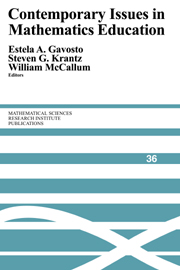Book contents
Japan: A Different Model of Mathematics Education
Published online by Cambridge University Press: 27 June 2025
Summary
Undergraduate and K-12 mathematics education in the United States have seen many reforms during the past decade. With the initial results of the Third International Mathematics and Science Study (TIMSS) appearing in October, 1996, there is also considerable interest in mathematics education elsewhere, especially Japan. A major revision in the K-12 curriculum in Japan has recently occurred, and the Mathematical Society of Japan has formed the Working Group for Undergraduate Mathematics, a committee of educators and mathematicians, to examine undergraduate mathematics education in Japan.
The success of the Japanese educational system in producing students who excel in mathematics is well-known and is pointed out in the results of TIMSS. This study was sponsored by the International Association for the Evaluation of Educational Achievement and involved approximately fifty nations world-wide. TIMSS focused on grades four, eight, and twelve, with Germany, Japan, and the United States receiving special attention [16; 17]. Unlike the National Council of Teachers of Mathematics Standards, which merely makes recommendations for K-12, Japan has a nationally set curriculum [5; 6; 12]. Since a fifth grade mathematics class in Tokyo will be covering roughly the same material as a class in Nagasaki or Sapporo during any given time of the academic year, Japanese educators have an opportunity to collaborate and polish lessons on a nationwide scale. This is not the case in U.S. schools, where the curriculum is locally controlled. In fact, the “TIMSS study of curricula found that current U.S. standards are unfocused and aimed at the lowest common denominator.
Information
- Type
- Chapter
- Information
- Contemporary Issues in Mathematics Education , pp. 75 - 82Publisher: Cambridge University PressPrint publication year: 1999
